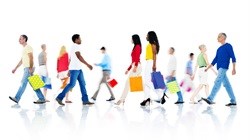Research shows SA's service really does suck
The 2013 'Benchmarking the South African Shopping Centre Industry' report pegs the number of shopping malls in South Africa at over 1,780, covering around 1 million square metres of floor space, which is more than all the malls in the rest of Africa combined. In a country where total retail spend is estimated at around R700 billion, more than half is spent in these malls. The Retail Shopper Report by WhyFive aims to offer retailers and marketers a clear view of consumer behaviour, needs and perceptions in order for them to grab a slice of this massive pie.
WhyFive research specialist Alan Todd said, "[The survey is] designed to expose what's driving the shopping behaviour of 'economically active' consumers (ie those living in households earning over R10k a month)... Being 'consumer-centric' in your thinking is a modern marketing mantra that really makes sense and it's not difficult. You simply have to be brave enough to ask the question, what does my customer think?"
WhyFive's 2014 Retail Shopper Report (based on an online survey with a substantial sample of 8000 respondents from all over the country) revealed these 10 key characteristics:
- Service sucks: perhaps the most disappointing metric to come out of the study is just how bad the scores are for how people perceive service standards at retail outlets. With 46% ticking the 'generally poor' box and another 10% selecting 'terrible', there's as much room for improvement in service, as there is for new malls.
- Proximity is key: shopping centres are spreading like a virus - particularly in Gauteng. How do they survive? Respondents showed a huge reluctance to travelling far to shop (69% prefer 'stores that are located nearby'). Whether its petrol prices, time constraints or changing expectations, the catchment area for malls has shrunk dramatically.
- Shopping is not fun: 80% of shopping is for necessities. Therefore, shoppers are mostly there because they have to be, not because they want to be. In addition, 86% are very cautious about spending money, so retailers who find ways to sweeten the occasion are more likely to win wallets and build loyalty.
- The web of knowledge: apart from the rise in online shopping, an even greater impact of the Internet on the retail environment is that shoppers have never been better informed: 59% always research online for specific categories of goods. Moreover, they can get information during and after shopping, so there is just nowhere to hide if you are hoping to pull the wool over anyone's eyes. Transparency is vital.
- Smartphone payment: purchase and payment from mobile devices is considered a great idea (35% would 'definitely or probably' use the service) - so Standard Bank's SnapScan is right on the money. Its potential is limited only by consumer education, something Retail Shopper 2015 is going to unpack in detail.
- The Internet is for pleasure and leisure: although Internet shopping is on the up, 59% of shoppers use it to buy books, movies and music - pleasure purchases where 'tangibility' is irrelevant. This is one of the major trends that RS will track.
- Loyalty programs: 'Benefit programs' make a massive difference to perception and behaviour - and 96% of respondents claim to use loyalty programs.
- Sales still work: In a similar vein to loyalty, bargain hunting is as important for the uppermost end of the market as it is for the lower. 78% of respondents claimed to 'sometimes or often' be tempted to buy products just because they are on promotion.
- Customers want you to talk to them: An important characteristic and the data shows that printed catalogues and e-mail newsletters rock: 93% sometimes, often or always read catalogues, 46% subscribe to digital newsletters and of those, 99% sometimes, often or always read them. In-store radio stations? They are a waste of energy: 64% say they do not even notice them, or regard them as a waste of time.
- Mall mimicry: Finally, Todd and his colleagues theorise that the proliferation of malls has flattened out the landscape so all malls looks the same: same banks, retailers, outlets, food chains et al. Consumers certainly recognise this characteristic, but for 2015, the RS Report is going to answer whether it is a good thing or an opportunity to differentiate.
Scheduled to go to field early next year, The Retail Shopper Report 2015 will consist of core findings together with bespoke silos that are 'owned' by partners in the survey. Said Todd, "The study will benefit any merchandise segment because once you've got the core data; you can then take those insights down into a special interest area. Our partners in the past have included grocers, fashion outlets, sunglasses shops, apparel outlets, building suppliers and even shopping malls."


























